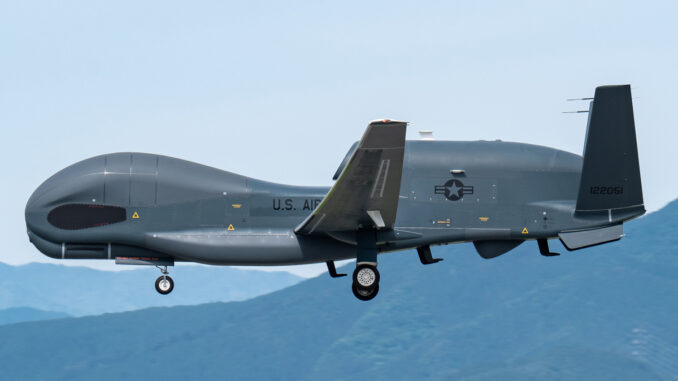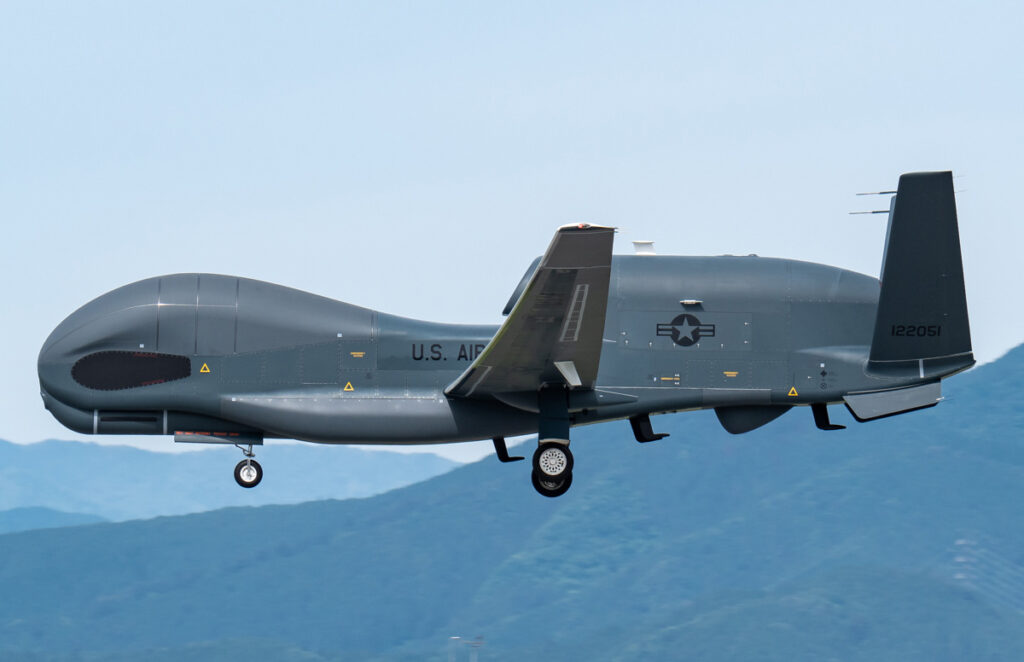
The RQ-4 Global Hawk lands in the UK for the first time, paving the way for strategic UAS operations for the USAF and NATO.
On 22 August, a U.S. Air Force RQ-4 Global Hawk UAV landed in the United Kingdom for the first time, marking the beginning of a new era in unmanned aerial system (UAS) operations from RAF Fairford. This event is crucial to strengthening NATO and US reconnaissance and surveillance capabilities in Europe. The landing, after a flight of almost 24 hours from Italy, involved the use of specially modified airspace to accommodate these high-altitude drones. This development is part of the USAF’s strategy to disperse its assets to improve resilience and operational flexibility.
First landing of the RQ-4 Global Hawk in the UK: a strategic milestone
On 22 August, an RQ-4 Global Hawk UAV, also known as Forte 12, made a historic landing at RAF Fairford air base, marking the first operation of its type on British soil. The flight, which lasted almost 24 hours, began in Sigonella, Italy, and took in much of Eastern Europe and Scandinavia before descending on the UK. The drone, the largest Unmanned Aerial System (UAS) to land in the UK, required significant airspace adjustments, with a specially created perimeter to allow the aircraft to descend safely from its cruising altitude of over 15,000 metres.
The RQ-4 Global Hawk is a high-altitude, long-endurance reconnaissance drone capable of flying for more than 30 hours and covering distances of more than 22,000 kilometres. It is equipped with state-of-the-art sensors that provide images and intelligence in real time, making it an essential strategic asset for surveillance and reconnaissance missions. The landing in the UK follows a series of consultations between the UK Ministry of Defence and the Civil Aviation Authority, which finally gave the go-ahead for the use of UK airspace for these missions.
Changes to UK airspace: adapting to UAS requirements
To enable the landing and future operations of the RQ-4 Global Hawk in the UK, significant changes have been made to the airspace around RAF Fairford. The UK Ministry of Defence submitted an application back in November 2021 to create a segmented airspace, known as the EDG218 complex, which allows the drone to climb and descend safely. This airspace is activated by a Notice to Airmen at least 24 hours before each operation, and remains open for a three-hour window, allowing sufficient flexibility to manage emergency situations.
The airspace over the UK is particularly congested, with heavy traffic from London airports and transatlantic flights. The changes made to accommodate the Global Hawk have raised concerns, particularly about the potential impact on operations at Birmingham Airport, some 80 kilometres north of Fairford. However, the MoD sees the flights as strategically and operationally vital to the UK and its allies, helping to strengthen bilateral relations with the US and NATO.

Implications for reconnaissance and surveillance operations in Europe
The landing of the Global Hawk in the UK is part of a wider USAF strategy to disperse assets across Europe to enhance resilience and operational flexibility. This strategy, known as Agile Combat Employment (ACE), aims to use alternative airfields to reduce the vulnerability of US air forces in the event of conflict. RAF Fairford, already used for bomber and reconnaissance deployments, will become a key hub for high-altitude UAS operations, gradually replacing the U-2s currently stationed at the base.
The RQ-4 Global Hawk, with its long-endurance surveillance capabilities, is a valuable asset for monitoring military activities in Europe, particularly in sensitive areas such as the Black Sea, where it has already carried out missions from the Sigonella naval base in Italy. These flights, often coordinated with NATO allies, enable critical intelligence to be gathered, particularly on Russian military movements in Ukraine. The integration of the Global Hawk into UK operations not only enhances the capabilities of the USAF, but also those of NATO, by providing continuous surveillance over vast geographical areas.
Geopolitical and strategic consequences of the integration of the Global Hawk in the UK
The arrival of the RQ-4 Global Hawk in the UK has significant geopolitical implications, particularly in the context of current tensions with Russia and NATO’s need to strengthen its defensive posture in Europe. By stationing these UAVs on UK soil, the US and its allies are strengthening their ability to monitor adversary military activity, deter hostile action and respond rapidly in the event of a crisis.
In addition, UK-US cooperation in the use of RAF Fairford for UAS operations strengthens transatlantic ties and underlines the strategic importance of the UK as a key NATO partner. The base, already used for temporary deployments of B-52 bombers and U-2 reconnaissance missions, will become a hub for high-altitude surveillance and reconnaissance missions, providing persistent coverage over Europe and beyond.
However, this increased militarisation of British airspace could also have consequences for relations with other European countries, particularly those that might take a dim view of increased military activity in their immediate neighbourhood. Questions of air sovereignty and airspace control could become points of friction, requiring close diplomatic coordination to avoid misunderstandings.
Conclusion: A technological and strategic breakthrough for the USAF and NATO
The landing of the RQ-4 Global Hawk in the UK marks a turning point in unmanned aerial system operations in Europe. This development reflects the commitment of the United States and NATO to strengthening their surveillance and reconnaissance capabilities, while adapting to current geopolitical challenges. The changes to UK airspace, while complex, are essential to ensure the safety and effectiveness of these operations.
In the long term, the integration of the Global Hawk into RAF Fairford’s operations could transform the base into a strategic centre for high-altitude surveillance missions, strengthening NATO’s defensive posture in Europe. The geopolitical and strategic implications of this development are profound, and are likely to shape transatlantic relations and the security dynamic in Europe for years to come.
War Wings Daily is an independant magazine.